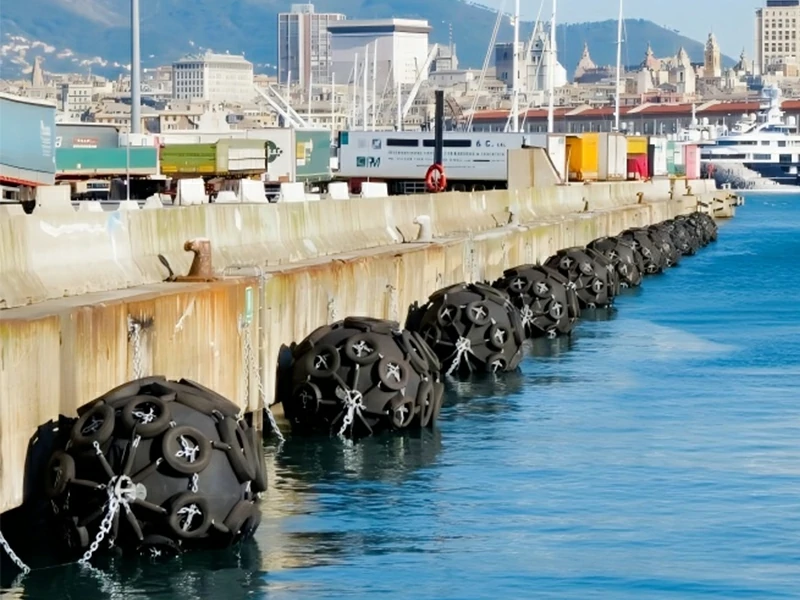كيفية اختيار نظام الوسادة الهوائية البحرية المناسب لإطلاق السفن
03/05/2025Applications of Square Fenders
03/07/2025مقدمة إلى مصدات الرصيف المائي



Jetty fenders, also known as dock bumpers or marina fenders, are essential components of port and dock infrastructure designed to protect ships, piers, and other marine structures from damage during berthing operations. These robust yet flexible barriers absorb the kinetic energy generated by a vessel’s movement—such as wind, waves, or human error—when it docks or undocks. By cushioning collisions, jetty fenders prevent costly repairs, ensure safe loading/unloading operations, and extend the lifespan of both vessels and terminals.
Key Functions of Jetty Fenders
- Shock Absorption:
- Mitigate the impact forces between a ship’s hull and the dock, reducing the risk of scratches, dents, or structural damage.
- Absorb energy from sudden movements caused by tidal shifts, currents, or storms.
- Structural Protection:
- Safeguard pier columns, decking, and mooring equipment from wear and tear.
- Prevent ships from drifting excessively during loading or unloading.
- Environmental Adaptability:
- Accommodate varying water levels (tides, flooding) and vessel sizes.
- Resist corrosion, UV radiation, and extreme temperatures in marine environments.
Common Types of Jetty Fenders
Jetty fenders are categorized based on their design, material, and functionality:
1. Rubber Fenders
- المواد: Synthetic rubber or natural rubber compounds.
- سمات:
- High flexibility and energy-absorbing capacity.
- Available in cylindrical, rectangular, or spherical shapes.
- Ideal for small to medium-sized vessels in calm waters.
- التطبيقات: Marinas, yacht clubs, and sheltered ports.
2. Composite Fenders
- المواد: Fiberglass-reinforced polymer (FRP) or polyurethane.
- سمات:
- Lightweight, durable, and resistant to marine fouling.
- Customizable shapes for specific dock geometries.
- Lower maintenance requirements compared to rubber.
- التطبيقات: High-traffic ports, industrial terminals, and offshore structures.
3. Inflatable Fenders
- المواد: Reinforced rubber or polyvinyl chloride (PVC).
- سمات:
- Collapsible design for easy storage and deployment.
- Adjustable inflation pressure to adapt to different vessel sizes.
- Effective in areas with limited space or dynamic water conditions.
- التطبيقات: Temporary docks, floating terminals, and rapid-response scenarios.
4. Concrete Fenders
- المواد: Steel-reinforced concrete or prestressed concrete.
- سمات:
- Extremely durable and resistant to heavy impacts.
- Permanent installations requiring significant upfront infrastructure.
- التطبيقات: Large commercial ports, naval bases, and deep-water terminals handling massive vessels (e.g., tankers, container ships).
Material Considerations
- متانة: Resistance to saltwater, UV degradation, and microbial growth.
- المرونة: Ability to deform without cracking under impact.
- Low Maintenance: Minimal upkeep requirements for long-term performance.
التركيب والصيانة
- التركيب:
- Anchored to the dock structure via bolts, suction cups, or grouted foundations.
- Positioned at strategic points along the pier to maximize protection.
- صيانة:
- Regular inspection for cracks, abrasions, or signs of fatigue.
- Cleaning to remove algae, barnacles, or debris that could compromise performance.
- Replacement of worn components to ensure reliability.
Standards and Compliance
Jetty fenders must comply with international safety and environmental regulations, such as:
- ASTM International: Testing standards for material strength and impact resistance.
- ISO 17363: Guidelines for marine fender systems.
- Local Maritime Authorities: Specific requirements for coastal zones or environmentally sensitive areas.
Benefits of High-Quality Jetty Fenders
- Cost Savings: Reduce repair expenses for ships and docks.
- Operational Efficiency: Minimize downtime during berthing operations.
- Environmental Sustainability: Prevent oil spills or chemical leaks caused by collisions.
خاتمة
Jetty fenders are critical for ensuring safe and efficient maritime operations. Choosing the right type depends on factors like vessel size, water conditions, budget, and long-term performance needs. By investing in high-quality fenders and adhering to proper maintenance protocols, ports and marinas can safeguard their infrastructure while supporting the global maritime economy.
